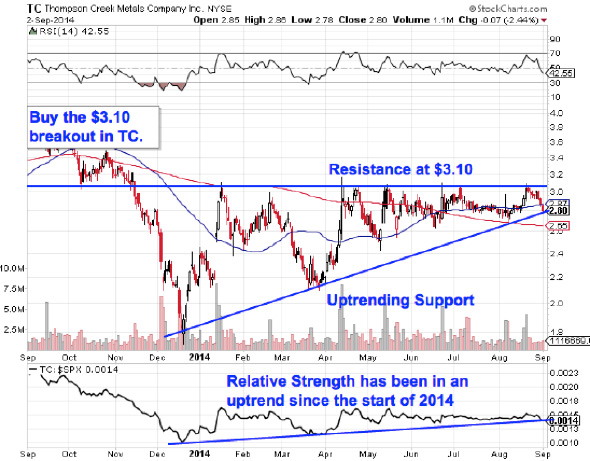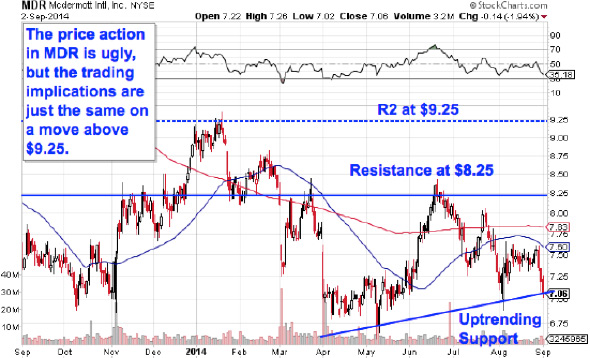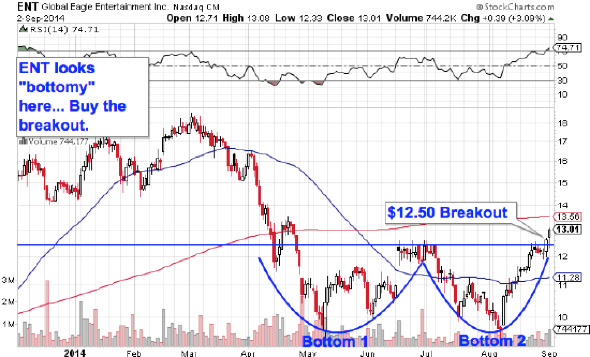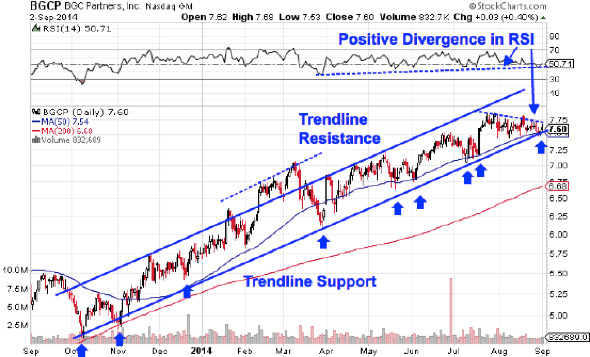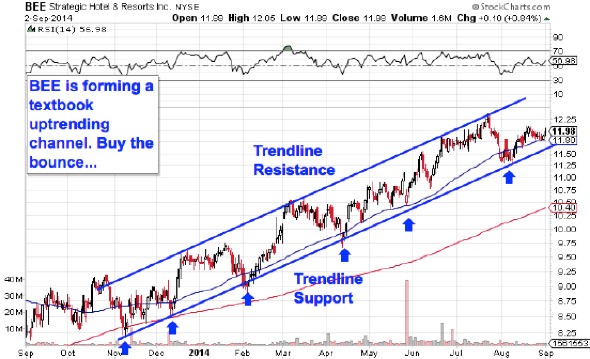DELAFIELD, Wis. (Stockpickr) -- Short-sellers hate being caught short a stock that reports a blowout quarter. When this happens, we often see a tradable short squeeze develop as the bears rush to cover their positions to avoid big losses. Even the best short-sellers know that it's never a great idea to stay short once a bullish earnings report sparks a big short-covering rally.
>>Where's the S&P Headed From Here? Higher!
This is why I scan the market for heavily shorted stocks that are about to report earnings. You only need to find a few of these stocks in a year to help enhance your portfolio returns -- the gains become so outsized in such a short time frame that your profits add up quickly.
That said, let's not forget that stocks are heavily shorted for a reason, so you have to use trading discipline and sound money management when playing earnings short-squeeze candidates. It's important that you don't go betting the farm on these plays and that you manage your risk accordingly. Sometimes the best play is to wait for the stock to break out following the report before you jump in to profit off a short squeeze. This way, you're letting the trend emerge after the market has digested all of the news.
Of course, sometimes the stock is going to be in such high demand that you risk missing a lot of the move by waiting. That's why it can be worth betting prior to the report -- but only if the stock is acting technically very bullish and you have a very strong conviction that it is going to rip higher. Just remember that even when you have that conviction and have done your due diligence, the stock can still get hammered if The Street doesn't like the numbers or guidance.
>>5 Rocket Stocks to Buy in February
If you do decide to bet ahead of a quarter, then you might want to use options to limit your capital exposure. Heavily shorted stocks are usually the names that make the biggest post-earnings moves and have the most volatility. I personally prefer to wait until all the earnings-related news is out for a heavily shorted stock and then jump in and trade the prevailing trend.
With that in mind, here's a look at several stocks that could experience big short squeezes when they report earnings this week.
Tableau Software
My first earnings short-squeeze trade idea is computer software player Tableau Software (DATA), which is set to release numbers on Tuesday after the market close. Wall Street analysts, on average, expect Tableau Software to report revenue of $258.50 million on earnings of 2 cents per share.
>>5 Stocks Ready to Break Out
Just recently, Goldman Sachs Group said it believes Tableau Software is well-positioned to benefit from Big Data analytic trends, and the firm upgraded shares to buy from neutral to reflect higher estimates and growth and raised its price target to $92 from $77 per share.
The current short interest as a percentage of the float for Tableau Software is pretty high at 9.2%. That means that out of the 15.93 million shares in the tradable float, 1.21 million shares are sold short by the bears. This is a high short interest on a stock with a very low tradable float. Any bullish earnings news could easily spark a monster short-squeeze for shares of DATA post-earnings.
From a technical perspective, DATA is currently trending above both its 50-day and 200-day moving averages, which is bullish. This stock has been uptrending strong over the last three months, with shares moving higher from its low of $58.96 to its recent high of $82.33 a share. During that uptrend, shares of DATA have been consistently making higher lows and higher highs, which is bullish technical price action. That move has now pushed shares of DATA within range of triggering a near-term breakout trade post-earnings.
If you're bullish on DATA, then I would wait until after its report and look for long-biased trades if this stock manages to break out above its all-time high of $82.33 a share with high volume. Look for volume on that move that hits near or above its three-month average action of 705,721 shares. If that breakout hits, then DATA will set up to enter new all-time-high territory, which is bullish technical price action. Some possible upside targets off that breakout are $95 to $100 a share.
I would simply avoid DATA or look for short-biased trades if after earnings it fails to trigger that breakout and then drops back below some near-term support levels at $74 to $72.40 a share with high volume. If we get that move, the DATA will set up to re-test or possibly take out its next major support levels at its 50-day moving average of $68.99 to $62 a share.
Alliance Fiber Optic Products
Another potential earnings short-squeeze play is semiconductor player Alliance Fiber Optic Products (AFOP), which is set to release its numbers on Monday after the market close. Wall Street analysts, on average, expect Alliance Fiber Optic Products to report revenue $22.68 million on earnings of 32 cents per share.
>>3 Big Tech Stocks on Traders' Radars
The current short interest as a percentage of the float for Alliance Fiber Optic Products is very high at 12.4%. That means that out of the 12.56 million shares in the tradable float, 1.56 million shares are sold short by the bears. This is a large short interest on a stock with very low tradable float. If the bulls get the earnings news they're looking for, then shares of AFOP could easily spike sharply higher post-earnings as the bears rush to cover some of their positions.
From a technical perspective, AFOP is currently trending just above both its 50-day and 200-day moving averages, which is bullish. This stock has been uptrending a bit over the last two months, with shares moving higher from its low of $13.42 to its recent high of $17.81 a share. During that move, shares of AFOP have been making mostly higher lows and higher highs, which is bullish technical price action. That move has now pushed shares of AFOP within range of triggering a major breakout trade post-earnings.
If you're in the bull camp on AFOP, then I would wait until after its report and look for long-biased trades if this stock manages to break out above some near-term overhead resistance levels at $17 to $17.81 a share with high volume. Look for volume on that move that hits near or above its three-month average action of 549,548 shares. If that breakout hits, then AFOP will set up to re-test or possibly take out its next major overhead resistance levels at $21.50 to $23 a share.
I would simply avoid AFOP or look for short-biased trades if after earnings it fails to trigger that breakout and then drops back below its 200-day moving average of $14.89 a share to more key near-term support at $14.41 a share with high volume. If we get that move, then AFOP will set up to re-test or possibly take out its next major support levels at $13.42 to $12 a share, or even $10 a share.
Green Plains Renewable Energy
Another potential earnings short-squeeze candidate is Green Plains Renewable Energy (GPRE), a producer, marketer and distributer of ethanol, which is set to release numbers on Wednesday after the market close. Wall Street analysts, on average, expect Green Plains Renewable Energy to report revenue of $798.08 million on earnings of 40 cents per share.
>>4 Stocks Rising on Big Volume
Just recently, Stephens downgraded shares of Green Plains Renewable Energy to equal weight from overweight due to valuation and lack of visibility.
The current short interest as a percentage of the float for Green Plains Renewable Energy is extremely high at 33.5%. That means that out of the 21.83 million shares in the tradable float, 8.83 million shares are sold short by the bears. The bears have also been increasing their bets from the last reporting period by 8.8%, or by about 712,000 shares. If the bears get caught pressing their bets into a strong quarter, then shares of GPRE could easily explode higher post-earnings as the shorts jump to cover some of their trades.
From a technical perspective, GPRE is currently trending above both its 50-day and 200-day moving averages, which is bullish. This stock has been uptrending strong for the last two months and change, with shares moving higher from its low of $13.75 to its recent high of $22.66 a share. During that uptrend, shares of GPRE have been consistently making higher lows and higher highs, which is bullish technical price action. That move has now pushed shares of GPRE within range of triggering a big breakout trade post-earnings.
If you're bullish on GPRE, then I would wait until after its report and look for long-biased trades if this stock manages to break out above its 52-week high at $22.66 a share with high volume. Look for volume on that move that hits near or above its three-month average action of 886,113 shares. If that breakout hits, then GPRE will set up to enter new 52-week-high territory, which is bullish technical price action. Some possible upside targets off that breakout are $27 to $30 a share.
I would avoid GPRE or look for short-biased trades if after earnings it fails to trigger that breakout and then drops back below some key near-term support at $20.75 a share with high volume. If we get that move, then GPRE will set up to re-test or possibly take out its next major support levels at its 50-day moving average of $18.87 a share to $18.02 a share. Any high-volume move below those levels will then put its 200-day moving average at $16.14 into range for shares of GPRE.
Outerwall
Another earnings short-squeeze prospect is automated retail solutions provider Outerwall (OUTR), which is set to release numbers on Thursday after the market close. Wall Street analysts, on average, expect Outerwall to report revenue of $595.34 million on earnings of $1.22 per share.
>>5 Stocks Under $10 Set to Soar
Just recently, Northland Securities said it believes that revenue from Outerwall's Redbox business should be up 1.5% quarter-over-quarter, slightly above the firm's previous estimate of about $494 million. However, the firm warns that the company could provide cautious Q1 guidance due to the Winter Olympics, and it expects the company's Q1 revenue to miss the consensus estimate. Nonetheless the firm is sticking with its outperform rating and $78 a share price target on the stock.
The current short interest as a percentage of the float for Outerwall is extremely high at 31.1%. That means that out of the 21.13 million shares in the tradable float, 8.51 million shares are sold short by the bears. This is a monster short interest on a stock with a very low tradable float. Any bullish earnings news could easily spark a massive short-squeeze for shares of OUTR post-earnings.
From a technical perspective, OUTR is currently trending above its 200-day moving average and just below its 50-day moving average, which is neutral trendwise. This stock has been trending sideways and consolidating for the last four months, with shares moving between $61.22 on the downside and $72.09 on the upside. Any high-volume move above the upper-end of its recent sideways trading chart pattern could trigger a big breakout trade for shares of OUTR post-earnings.
If you're bullish on OUTR, then I would wait until after its report and look for long-biased trades if this stock manages to break out above its 50-day moving average of $66.70 to $70 a share and then once it clears more key resistance levels at $70.44 to its 52-week high at $72.09 a share with high volume. Look for volume on that move that hits near or above its three-month average action of 528,589 shares. If that breakout hits, then OUTR will set up to enter new 52-week-high territory above $72.09, which is bullish technical price action. Some possible upside targets off that breakout are $80 to $90 a share.
I would simply avoid OUTR or look for short-biased trades if after earnings it fails to trigger that breakout and then drops back below some key near-term support levels at $63 to its 200-day moving average of $61.11 a share with high volume. If we get that move, then OUTR will set up to re-test or possibly take out its next major support levels at $58 to $52 a share.
Twitter
My final earnings short-squeeze play is social media player Twitter (TWTR), which is set to release numbers on Wednesday after the market close. Wall Street analysts, on average, expect Twitter to report revenue of $217.78 million on a loss of 2 cents per share.
>>4 Huge Stocks to Trade (or Not)
Just this morning, RBC Capital analyst Mark Mahaney said Twitter's fourth quarter results could exceed analysts' consensus by a small amount, although it is difficult to gauge the company's fundamentals. Also this morning, Wedbush analyst Shyam Patil said that Twitter benefited from strong spending on its platform last quarter and some advertisers are beginning to dedicate a set amount of money to Twitter in their budgets. However, Patil said Twitter's fourth quarter results are likely to be in-line with analysts' consensus estimates, and investors should wait for a better entry point before buying the shares.
The current short interest as a percentage of the float for Twitter is very high at 15%. That means that out of the 284.36 million shares in the tradable float, 32.69 million shares are sold short by the bears. The bears have also been increasing their bets from the last reporting period by 11.3%, or by about 3.31 million shares. If the bears get caught pressing their bets into a bullish quarter, then shares of TWTR could rip sharply higher post-earnings as the bears rush to cover some of their bets.
From a technical perspective, TWTR is currently trending above its 50-day moving average, which is bullish. This stock recently formed a double bottom chart pattern at $55.59 to $56.10 a share. Following that bottom, shares of TWTR have started to uptrend and break out above some near-term overhead resistance at $64.69 a share. That move is quickly pushing shares of TWTR within range of triggering an even bigger breakout trade post-earnings into new all-time-high territory.
If you're in the bull camp on TWTR, then I would wait until after its report and look for long-biased trades if this stock manages to break out above some key near-term overhead resistance levels at $70.43 a share to its all-time high at $74.73 a share with high volume. Look for volume on that move that hits near or above its three-month average volume of 21.88 million shares. If that breakout hits, then TWTR will set up to enter new all-time-high territory, which is bullish technical price action. Some possible upside targets off that breakout are $80 to $90 a share.
I would avoid TWTR or look for short-biased trades if after earnings it fails to trigger that breakout, and then drops back below some near-term support at $60 a share with high volume. If we get that move, then TWTR will set up to re-test or possibly take out its next major support levels at those double bottom prices of $56.10 to $55.59 a share.
To see more potential earnings short squeeze plays, check out the Earnings Short-Squeeze Plays portfolio on Stockpickr.
-- Written by Roberto Pedone in Delafield, Wis.
RELATED LINKS:
>>3 Stocks Breaking Out on Unusual Volume
>>5 Big Trades to Profit During the Fed's QE Pay Cut
>>5 Short-Squeeze Stocks That Could Pop in February
Follow Stockpickr on Twitter and become a fan on Facebook.
At the time of publication, author had no positions in stocks mentioned.
Roberto Pedone, based out of Delafield, Wis., is an independent trader who focuses on technical analysis for small- and large-cap stocks, options, futures, commodities and currencies. Roberto studied international business at the Milwaukee School of Engineering, and he spent a year overseas studying business in Lubeck, Germany. His work has appeared on financial outlets including
CNBC.com and Forbes.com.
You can follow Pedone on Twitter at www.twitter.com/zerosum24 or @zerosum24.
It has been a long time since Crocs (CROX) was fashionable—both with its clunky shoes on Main Street and with its clunky shares on Wall Street.
